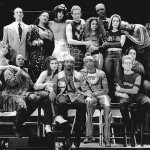After a series of private, closed, and open readings, you will probably be anxious to see your musical on stage. Before you rush to book a theater, though, it’s a good idea (creatively and financially) to take one more step — and do a workshop instead of a full production. A workshop is a staged performance, but one with modest production elements. For example, a workshop may not have costumes, sets, or even a full musical accompaniment.
The primary purpose of a workshop is to refine your show based on a wider sampling of audience reaction than any reading allows. Only with an audience can you know what’s landing and what’s failing. “It’s all about figuring out what people are getting,” playwright Richard Greenberg said. “You get in front of a bunch of strangers, and you can hear when something is mystifying.”
Since workshops cost less than full productions, smaller companies (including community and youth theaters) are good places to consider sending your script. That’s how Rent began. In 1992, Jonathan Larson sent a tape and script to New York Theatre Workshop, which gave the musical a staged reading the following year. After that, Larson trimmed and simplified the complex plot, and NYTW produced another workshop in 1994. Larson continued to work on Rent through two more workshops, before NYTW gave the show a full Off-Broadway production in 1996.
You can also produce your own workshop in a cabaret room or community hall. It’s a lot more work, but that’s what Danny Goggin did with Nunsense, which opened for a four-day run at The Duplex, a Greenwich Village cabaret theater, and stayed for almost a year. Encouraged, Goggin expanded his revue into a full-length musical that ran Off-Broadway for ten years, becoming the second-longest running Off-Broadway show in history.
For more about self-producing, read Producing Your Own Showcase (2001) by playwright Paul Harris. For another developmental success story, read about the making of A Chorus Line in the book The Longest Line (2000) by Gary Stevens. For a developmental cautionary tale, read about the missteps of Song of Spider-Man (2013), written by Spider-Man: Turn Off the Dark librettist Glen Berger.
Once you are offered a full production, your work isn’t done, though. As you receive feedback about the songs, scenes, and more in rehearsal, you should make rewrites to resolve important questions. Even during preview performances, continue to make needed rewrites. In professional theaters, previews are as much as part of the creative process as closed readings — and it’s not just the script that changes daily, but also everything from costumes to lights.
In her 1978 autobiography, actor Ethel Merman described the process of daily changes. “They never stopped trying to add a joke, tidy up an exit, improve a punch line. I went along with the tinkering until the Thursday before our New York opening, when the show was supposed to be frozen — meaning no more changes. Still they continued making a change here and there until I faced them down, saying, ‘Boys, as of right now, I am Miss Birdseye of 1950. I am frozen. Not a comma!’”
For an overview of readings, rehearsals, and more, read Working on a New Play (1988) by Edward M. Cohen. For advice on the production process, read playwright Stephen Spotswood’s essay on how be a writer in the rehearsal room. For a look behind the curtain, watch The Band Wagon (1953) or the TV series Smash (2012). Below is a clip from the Smash episode “Let’s Be Bad,” showing an example of what not to do in rehearsal.
Next, where to send your work.

